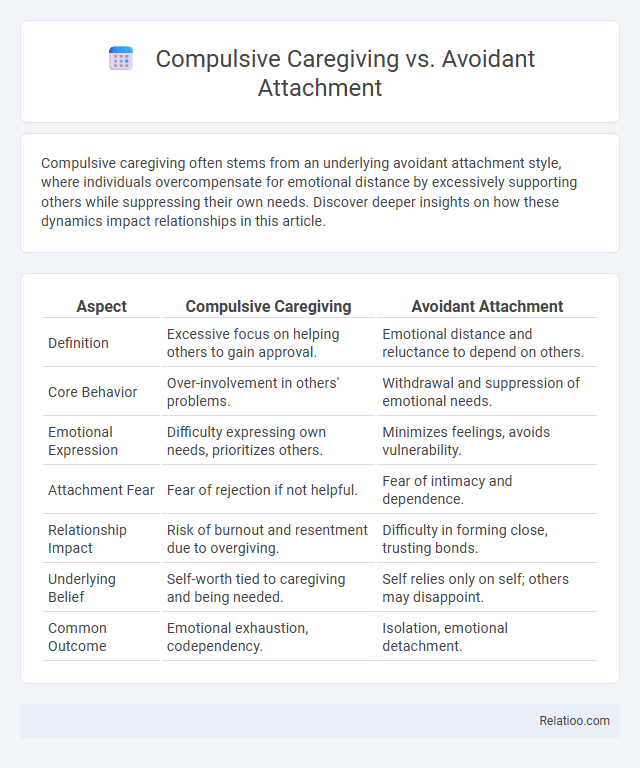Compulsive caregiving often stems from an underlying avoidant attachment style, where individuals overcompensate for emotional distance by excessively supporting others while suppressing their own needs. Discover deeper insights on how these dynamics impact relationships in this article.
Table of Comparison
| Aspect | Compulsive Caregiving | Avoidant Attachment |
|---|---|---|
| Definition | Excessive focus on helping others to gain approval. | Emotional distance and reluctance to depend on others. |
| Core Behavior | Over-involvement in others' problems. | Withdrawal and suppression of emotional needs. |
| Emotional Expression | Difficulty expressing own needs, prioritizes others. | Minimizes feelings, avoids vulnerability. |
| Attachment Fear | Fear of rejection if not helpful. | Fear of intimacy and dependence. |
| Relationship Impact | Risk of burnout and resentment due to overgiving. | Difficulty in forming close, trusting bonds. |
| Underlying Belief | Self-worth tied to caregiving and being needed. | Self relies only on self; others may disappoint. |
| Common Outcome | Emotional exhaustion, codependency. | Isolation, emotional detachment. |
Understanding Compulsive Caregiving
Compulsive caregiving is characterized by an excessive need to care for others, often at the expense of one's own needs and boundaries, driven by underlying attachment insecurities. This behavior contrasts with avoidant attachment, where individuals distance themselves emotionally and minimize dependency, avoiding caregiving roles to protect their independence. Understanding compulsive caregiving involves recognizing it as a maladaptive coping mechanism rooted in anxiety and fear of abandonment, commonly linked to anxious attachment styles.
Defining Avoidant Attachment
Avoidant attachment is characterized by emotional distancing and reluctance to depend on others, often resulting from early experiences of neglect or rejection. This attachment style leads individuals to prioritize self-reliance and suppress their need for closeness, contrasting with compulsive caregiving behavior that involves excessive caretaking to gain approval or control. While compulsive caregivers intensely seek connection through helping others, avoidantly attached individuals withdraw to protect themselves from vulnerability.
Key Differences Between Compulsive Caregiving and Avoidant Attachment
Compulsive caregiving involves an excessive need to care for others to gain approval and avoid personal discomfort, often leading to self-neglect and enabling unhealthy dependence. Avoidant attachment is characterized by emotional distancing and discomfort with intimacy, prompting individuals to suppress their needs and maintain independence to avoid vulnerability. The key difference lies in compulsive caregivers seeking connection through over-involvement, while avoidantly attached individuals protect themselves by minimizing emotional closeness.
Origins and Causes of Compulsive Caregiving
Compulsive caregiving often originates from early childhood experiences marked by neglect, inconsistent parenting, or emotional unavailability, leading individuals to develop caretaking behaviors as a means to gain approval and control. Unlike avoidant attachment, which stems from emotional distancing and fear of intimacy, compulsive caregiving is driven by deep-seated fears of abandonment and a need to feel indispensable. These origins create patterns where compulsive caregivers prioritize others' needs over their own, perpetuating cycles of dependency and emotional exhaustion.
Attachment Theory: The Foundation
Attachment Theory serves as the foundation for understanding compulsive caregiving and avoidant attachment, highlighting patterns of emotional bonding rooted in early relationships. Compulsive caregiving often emerges from anxious attachment, where Your need to care for others drives a fear of abandonment, contrasting with avoidant attachment characterized by emotional distance and self-reliance. These attachment styles influence interpersonal dynamics by shaping how individuals express needs and seek security within relationships.
Signs and Symptoms of Avoidant Attachment
Avoidant attachment is characterized by emotional detachment, difficulty trusting others, and a persistent preference for independence, often accompanied by suppressing feelings and avoiding intimacy. Individuals with avoidant attachment may exhibit signs such as discomfort with closeness, reluctance to rely on others, and a tendency to withdraw during conflicts, contrasting with compulsive caregiving which involves excessive nurturing behaviors. These symptoms can lead to challenges in forming secure relationships and maintaining emotional connections.
Impacts on Adult Relationships
Compulsive caregiving often leads to codependent relationships where Your emotional needs are overlooked, fostering imbalance and resentment. Avoidant attachment triggers emotional distance and difficulty with intimacy, resulting in partners feeling disconnected or unappreciated. Both patterns disrupt healthy communication and trust, impacting the stability and satisfaction of adult relationships significantly.
Healing From Compulsive Caregiving and Avoidant Behaviors
Healing from compulsive caregiving and avoidant attachment requires recognizing patterns that hinder emotional balance and personal boundaries. You must cultivate self-awareness and practice setting healthy limits while developing secure attachment strategies to foster genuine connections without overextending or withdrawing. Therapeutic interventions like cognitive-behavioral therapy and mindfulness can effectively address these behaviors by promoting emotional regulation and resilience.
Therapeutic Approaches for Secure Attachment
Therapeutic approaches for secure attachment emphasize building emotional regulation and trust through consistent, responsive caregiving, differentiating from compulsive caregiving patterns that often involve over-involvement or controlling behaviors. Avoidant attachment treatment focuses on increasing emotional awareness and promoting vulnerability in relationships, while addressing compulsive caregivers requires interventions that balance care with healthy boundaries. Techniques like attachment-based therapy, cognitive-behavioral therapy (CBT), and mindfulness strategies support individuals in developing secure attachment patterns by enhancing emotional connection and reducing maladaptive caregiving or avoidance behaviors.
Building Healthier Emotional Bonds
Compulsive caregiving often stems from avoidant attachment patterns, where individuals excessively care for others to meet their emotional needs while simultaneously keeping intimacy at a distance. Building healthier emotional bonds requires recognizing these tendencies, fostering vulnerability, and establishing boundaries to promote mutual trust and emotional regulation. Integrating mindfulness and secure attachment practices helps transform compulsive caregiving into balanced, reciprocal relationships.

Infographic: Compulsive caregiving vs Avoidant attachment
 relatioo.com
relatioo.com